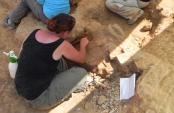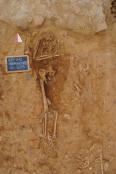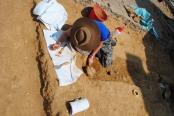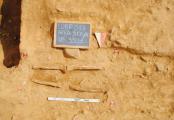CAMPAGNA 2013 |
1° SETTIMANA |
2° SETTIMANA |
3° SETTIMANA |
4° SETTIMANA |
5° SETTIMANA |
6° SETTIMANA |
7° SETTIMANA |
8° SETTIMANA |
19 LUGLIO 2013 
Resoconto della giornata di scavo
Area 1000
We got ready for the visit by the documentary crew that is coming on Monday.
David and Kailey Anabel pick axed the rest of the test pit and reached the level of one of the graves. They cleaned the surface so it looked presentable.
Everyone else cleaned the whole day.
Area 2000
Durante la pulizia generale del Settore B è stata individuata e documentata una buca circolare (US-2348) nell’angolo Sud orientale che risulta essere allineata alle altre distinte nell’allargamento dell’Area 1000. Nel Settore A si è proceduto alla completa messa in luce e rimozione dell’individuo USk 2340: si tratta di un individuo maschile molto ben preservato di circa 40 anni, orientato W/E, deposto in decubito dorsale con gli arti inferiori distesi paralleli e gli arti superiori leggermente flessi sul bacino. Ai lati del cranio sono state collocate due pietre come sorta di alveolo cefalico. Nel pomeriggio è stato inoltre documentato e rimosso USk 2346 all’interno della fossa sepolcrale US – 2344 nella porzione centro occidentale: come già detto, lo scheletro si conserva solo per la metà sinistra in quanto la destra risulta proseguire al di sotto del limite ovest dell’area di scavo. Dell’individuo, mal preservato, sono stati evidenziate le vertebre, alcune coste molto frammentate, parte del bacino, l’avambraccio sinistro e la tibia. L’attenzione si è, in aggiunta, spostata verso la vasca laterizia USM 2100: la rimozione totale dello strato sovrastante e del riempimento ancora visibili, ha permesso di mettere in evidenza, nell’angolo più occidentale, un piano pavimentale in mattoni che in origine doveva molto probabilmente essere disposto su tutto il fondo. Una pulizia più accurata permetterà di definire per meglio i limiti della struttura così da comprenderne la funzione ancora non chiara.
Today in Area 2000 we primarily concentrated our efforts in the northern section of Sector B. In US 2244 we continued to expose various cuts in an attempt to locate a cut associated with an exposed cranium. In the process a brick structure was exposed, possibly a floor or walkway, but we must excavate further to make a positive identification of the feature.
Skeleton USK 2340 was fully exposed today and photographs and GIS points were taken with the total station. After this, all skeletal elements were removed and wrapped for analysis in the lab. During this process, a cranium was found under the left os coxa. The cranium was covered to protect it over the weekend so it can be examined on Monday.
US 2346, a burial cut by the western wall of Area 200, was cleaned and photographs and GIS points were taken with the total station. While removing the fill, 2 tibias and a cranium not in association with US2346 were found. We are unsure of their origin, but additional photographs were taken to document their position.
A possible feature to the east of USK 2340 was explored today as well. It is a possible extension of the ossuary pit already excavated in Sector A. Found in the feature were small, degraded bone fragments as well as pieces of slate and brick. Due to the lack of large bone pieces, we do not think that the feature is a continuation of the ossuary pit, but we will continue to examine it to make sure.
In the SE wall of Sector B cut US 2248 was followed and the fill was removed. Nothing was found inside the cut apart from a large stone at the bottom. Photographs and GIS points were taken to document the cut.
Area 3000
Nel Settore A la rimozione dell’individuo scheletrizzato Us 3290, orientato W-E all’interno di US – 3291, ha permesso di individuare un’altra fossa sepolcrale (US – 3305), in cui è deposto lo scheletro Us 3303. Del corpo, mal preservato, si conserva solamente la porzione inferiore, in particolare i femori (eccetto le epifisi prossimali), le tibie, la fibula destra ed i piedi. Gli arti inferiori sono simmetrici e distesi, con le ginocchia e le caviglie convergenti. La parte superiore è stata intercettata ed asportata dallo scavo della fossa sepolcrale US – 3291, per l’inumazione di Us 3290, che presenta lo stesso orientamento di Us 3303. Nel Settore B è stata completata la messa in luce dell’individuo Us 3233, orientato N-S ed inumato in decubito dorsale all’interno di US – 3235, nella porzione N-W del settore, immediatamente a Sud del muro USM 3073. Lo scheletro risulta privo del cranio, probabilmente tagliato dalla fossa di spoliazione del perimetrale Nord; sono assenti anche l’omero, l’ulna, il coxale ed il femore sinistri, probabilmente intercettati dalla fossa sepolcrale US – 3289, per la deposizione di Us 3287, immediatamente ad Est. Gli arti superiori sono flessi sul ventre, mentre quelli inferiori sono simmetrici e distesi, con le ginocchia e le caviglie convergenti. Nel riempimento sono stati rinvenuti due vaghi di colore nero e di piccole dimensioni, appartenenti ad un rosario o ad una collanina. Nella porzione N-E continua lo scavo della trincea US – 3257, realizzata probabilmente come canaletta per il deflusso dell’acqua.>
Sector A removed clavicles, ribs and head of skeleton 3290. Cleaned the burial down to the cut level and removed the left foot. Cleaned and photographed the isolated twin femurs, tibiae and fibulae located in parallel to the east of 3290. This skeleton was given the identification 3303, is oriented west-east and appears to be cut at the distal end of the tibiae and proximal ends of the femurs. It is also slightly deeper than 3290 which assumably makes it older and appears to have been cut to accommodate for the bell pit to the east and skeleton 3290 to the west. After cleaning 3303 was removed and the burial levelled to the stratigraphy of the cut.
Skeleton 3275 continued exhuming the skull and vertebral column. Cleaned the area and exposed additional right ribs, vertebrae and skull fragments all of which were all removed and the burial was cleaned to the cut and photographed.
Continued to clean the northern most area of the new extension of sector A to make it presentable. Discovered a skeleton oriented west-east, includes long bones, pelvis and skull fragments. A unidentifiable bone at the distal end pelvis. To be excavated on Monday.
Sector B exhumed the skeleton 3233. Removed the tarsels, metatarsals, phalanges, right tibiae and fibula, the left tibia, right femur and sacrum. Vertebrae, pelvis, clavicles and both scapulae and ribs also removed.
Pick axed and trowelled three feet down for a length of five feet of trench 3258. Found scattered bone and modern pottery, expect to continue on Monday.
Area 4000
Settore A –Saggio 4800
L’allargamento del saggio permette ora di coprire l’intera larghezza del settore, da est ad ovest, intercettando così le fasi di fondazione della struttura US 4126. Come già detto, la distanza fra questa unità e l’altro alzato medievale, US 4062, è identica a quella fra le altre due strutture (US 4131 ed US 4134) site nella porzione opposta dell’area, a 13 mt di distanza. Tale simmetricità fa sempre più propendere all’ipotesi che ci si trovi ad indagare all’interno dei due corridoi laterali (orientati nord-sud) del chiostro. Il secondo punto investigativo del saggio riguardo l’indagine dei tagli (probabilmente sepolcrali) rinvenuti al di sotto del banco d’argilla (60 cm c.a. di spessore medio) che si estende su tutta l’area (US 4092, US 4801, US 4901, US 4116). Questo, essendo stato tagliato dalle strutture relative al chiostro (US 4062, US 4131), risulta antecedente ad esse, dunque ancora più antichi sono i tagli rinvenuti al di sotto di esso. Ad ora sarà importante dunque confermare la presenza di una eventuale area sepolcrale di fondazione anteriore alla costruzione del monastero.
Settore A – Saggio 4900
Anche in questo approfondimento iniziano a comparire, sotto il piano argilloso US 4901, dei tagli (US -4903) successivamente intaccati dalla posa delle strutture US 4062 ed US 4131. La recente apertura del saggio limita le informazioni, maggiori dettagli per quanto riguarda questo angolo nord occidentale del giardino del chiostro, verranno forniti con le prossime indagini.
Settore C – Allargamento Est
Mano a mano che i piani stradali di età contemporanea vengono rimossi, appare sempre più chiara la situazione, speculare al Settore A. Le strutture US 4131 ed US 4134, parallele, distanti 3,60 mt l’una dall’altra, sono colmate, nello spazio che le separa da un esteso strato di lastre di ardesia (US 4130, non propriamente strato di crollo ma azione di livellamento orizzontale di una precedente situazione di collasso strutturale). Ai lati esterni di queste due UUSS tale strato non trova continuità, ciò porta a confermare che la porzione centrale dell’area (settore B e metà del settore C) fosse quella relativa al giardino aperto del chiostro e che le due fasce laterali (stesse situazioni, due muri paralleli cadenzati da uno strato di lastre di ardesia livellate; al lato est ed a quello ovest dell’area) ne fossero i due corridoi con andamento nord-sud. Questi due “corridoi” trovano continuità (in senso est-ovest) nella presenza di US 4131, altra struttura dall’identica fattura e che, con US 4062 ed US 4131, forma i due angoli (Nord-Est e Nord-Ovest) del giardino.
 |
| Fotomosaico generale dell'area |
Today the test pit in Section A was expanded in order to expose a perceived burial and the rest of the far western wall. A large amount of teeth and bone fragments were found as well as pottery, a nail and a key.
In the test pit in Section B, we started to remove the fill in a small cut. In the process of doing so, we exposed the connection between the western and northern wall and found a large piece of bone and smaller fragments.
In Section C we cleaned areas 4132 and 4133 to take pictures and measured unknown points to put into AutoCAD to discover the exact points. Then we removed 4136 and 4135 found pottery, human bone and a nail. We also began removing 4133.















